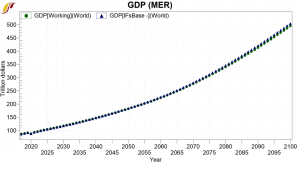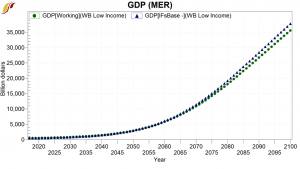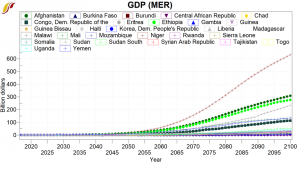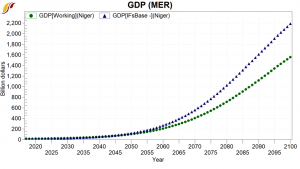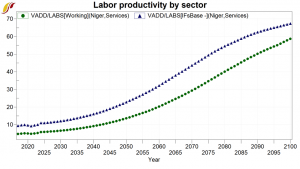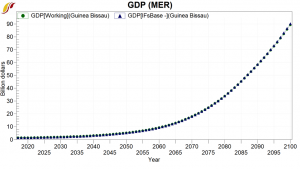Version 7.85 (June 7th, 2022)
PREVIOUS VERSION | INDEX PAGE | NEXT VERSION
You can download IFs Version 7.85 at 7.85 VB6 version and 7.85 NET version.
Interface Updates
- Fixed problem with translating option buttons in the Scenario Tree for Portuguese version.
- Fixed problem when creating formulas in Bilateral display, Show Formulas was always disabled.
- Installation now includes Portuguese files, so users can potentially turn-on Portuguese version by opening ifsInit.mdb, ifsInit table and changing the row for Language to Portuguese.
Model Updates
- Agricultural Labor only updated if we have enough Rural population:
The general purpose of GTAPDuplicate is to normalize the labor properly for grouped GTAP countries. These countries as you know starts with an “X” as the first letter of the GTAP code. This normalization was not initializing agricultural employment very well, especially for some African countries. So, for countries which are grouped in GTAP, we decided to read agricultural labor directly from the WDI data table – SeriesLaborAgriSector. The line that you mentioned, makes sure agricultural employment obtained from WDI is not way over the rural population.
- Fix limit on Agricultural Labor:
Some low income countries, have a lower GDP, close to 40% lower for Niger. These countries are now initialized with smaller share of labor force in ag, for example, 75% in Niger as opposed to 87% before code change. These previously-initialized as ag labors are now in service and manufacture. This reduces the initial labor productivity (VADD per labor) in these sectors, which seems to exacerbate over time, for reasons I don’t understand yet.
In the plots below, green in the base run with the changed code.
- Added parameter sfintlwaralltoginidom to create a direct link between conflict and inequality, turned off in the base case, but testing a value of 1.02 to increase 2% in inequality when conflict is present.
- Added WTEMP exogenous logic to be able to take RCP forecast values for global temperature.
- Gross Migration logic had been accidentally off since version 7.82, and it’s now ON again, as it should be, also added warning message in case we turn it OFF again for testing or building migration forecast.
- Added division by /100 to POWER in AID gravity function to fix a problem in bilateral AID estimates, trying with US vs Ukraine, we had no results saved after 2081 because values were too big or too small.
- Fixed problem with Poverty by age and sex, caused by fix for Portuguese version.
- Changed bilateral dependence to use additive shift factors instead of multiplicative.
- Added limits to AIDDON and AIDREC to avoid negatives.
- Added limit > 0 on adjusment to WatResTotalRenewSurface and WatResTotalRenewGround to avoid division by 0 (Bahamas), also checking for totalsupply > 0 for WATERDESALINATED (Micronesia), the data that required this change was left out of this version, but will be included in the next.
- Added logic to converge Income from Disposable (HHINCDIS) to Permanent (HHINCDISPERM) over 5 years after exogenous changes to GDP are done.
Data Updates
- Major updates are:
- World land temperature across 4 RCPs. You can search for SeriesForecastEnvWTempLandQuantityRCP for these 16 tables. For example, SeriesForecastEnvWTempLandMeanRCP85, SeriesForecastEnvWTempLandMedianRCP26, SeriesForecastEnvWTempLandP10RCP45, etc.
- Some ODA flow related data requested by Barry.
- A fix in the DataDict table.
- Diplometric monadic indicators from Caleb.
To expand on the point 2 above, I added 6 tables in total into this consolidation (7.85). I collected these series from OECD’s IDS database. Note that the GNI was based on WorldBank’s estimates.
| Variable |
| AidRec%GNIOECD |
| AidRecGrants%GNI |
| AidRecLoanGross%GNI |
| AidRecLoanNet%GNI |
| AidRecLoanRepay%GNI |
| AidRecRecover%GNI |
When data are available in the same year, following formulas should hold for a country,
- Net ODA = Grants + Recoveries + Net Loan
- Net Loan = Gross Loans + Loan Repayments
- AidRec%GNIOECD = Net ODA from OECD IDS as a percent of GNI from WorldBank. Thus, in theory, AidRec%GNIOECD should be exactly the same as AidRec%GNI in IFs. I checked and found some small differences. One explanation could be the WorldBank group is not using the latest data from OECD. Because you can see that most of values from WB stopped in 2019 while OECD have 2020 values now.
